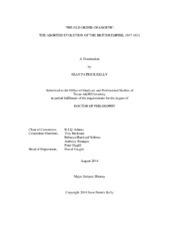| dc.description.abstract | In the aftermath of the Great War (1914-18), Britons could, arguably for the first time since 1763, look to the immediate future without worrying about the rise of an anti-British coalition of European states hungry for colonial spoils. Yet the shadow cast by the apparent ease with which the United States rose to global dominance after 1940 has masked the complexity and uncertainty inherent in what turned out to be the last decades of the British Empire. Historians of British international history have long recognised that the 1920s were a period of adjustment to a new world, not simply the precursor to the disastrous (in hindsight) 1930s. As late as the eve of the Second World War, prominent colonial nationalists lamented that the end of Empire remained impossible to foresee. Britons, nevertheless, recognised that the Great War had laid bare the need to modernise the archaic, Victorian-style imperialism denounced by The Times, amongst others.
Part I details the attempts to create a 'New Way of Empire' before examining two congruent efforts to integrate Britain‘s self-governing Dominions into the very heart of British political life. The first occurred during the final year of the War, when the apparatus to coordinate imperial governance began to take shape. However, owing to the unexpected end of the War in 1918, little came of the Committee of Prime Ministers. More than a decade later, the Canadian-born press baron, Lord Beaverbrook, sought to make Empire Free Trade the cornerstone of British politics, but his campaign was thwarted by 1) his own missteps and 2) the broader Establishment intent on preserving the restored, quasi-Edwardian political order. Part II deals with constitutional changes in Greater India, using the Viceroyalty of Lord Irwin (1926-31) and events in Ceylon and the investigations of the Donoughmore Commission as case studies. These examples saw Britons trying to counteract that impossible doctrine of Wilsonian self determination, while also thwarting bourgeois, colonial nationalists intent on supplanting British rule with 'a narrow oligarchy of clever lawyers'. | en |


